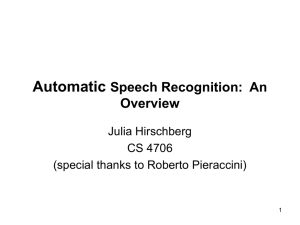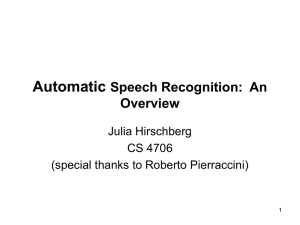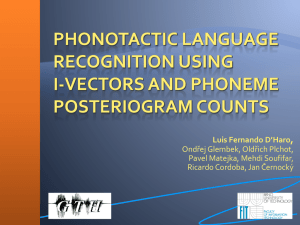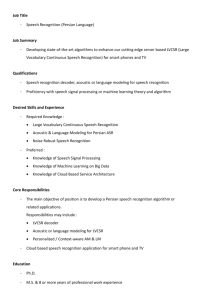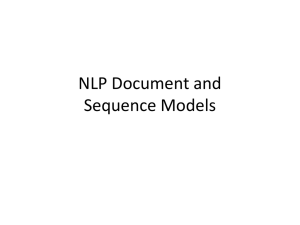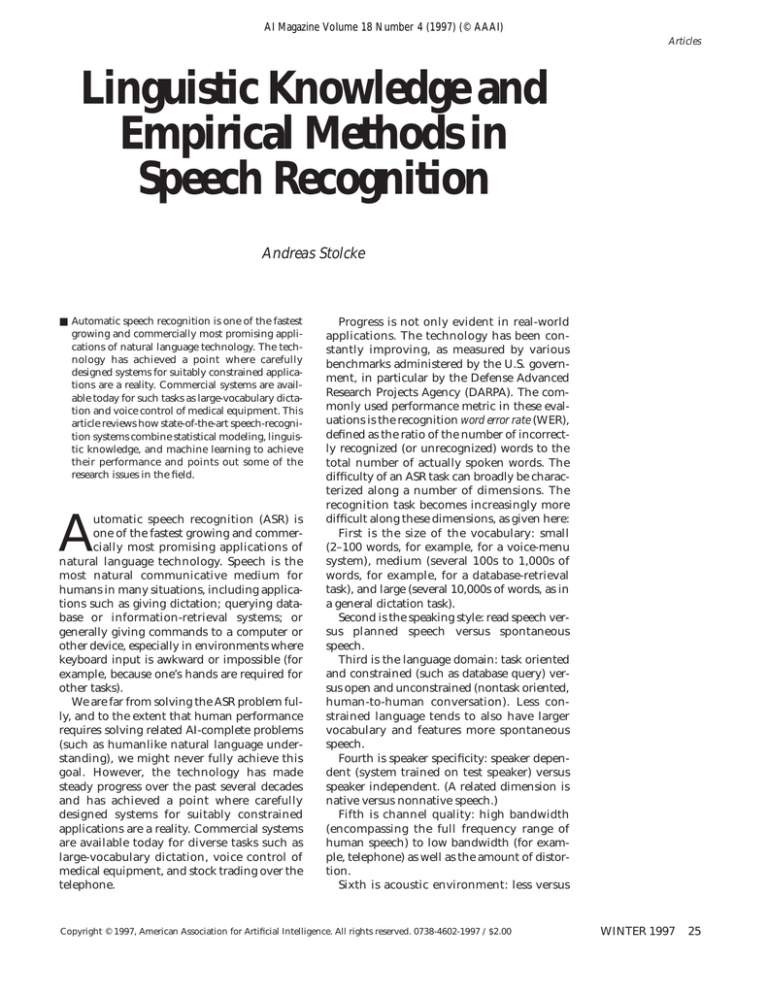
AI Magazine Volume 18 Number 4 (1997) (© AAAI)
Articles
Linguistic Knowledge and
Empirical Methods in
Speech Recognition
Andreas Stolcke
■ Automatic speech recognition is one of the fastest
growing and commercially most promising applications of natural language technology. The technology has achieved a point where carefully
designed systems for suitably constrained applications are a reality. Commercial systems are available today for such tasks as large-vocabulary dictation and voice control of medical equipment. This
article reviews how state-of-the-art speech-recognition systems combine statistical modeling, linguistic knowledge, and machine learning to achieve
their performance and points out some of the
research issues in the field.
A
utomatic speech recognition (ASR) is
one of the fastest growing and commercially most promising applications of
natural language technology. Speech is the
most natural communicative medium for
humans in many situations, including applications such as giving dictation; querying database or information-retrieval systems; or
generally giving commands to a computer or
other device, especially in environments where
keyboard input is awkward or impossible (for
example, because one’s hands are required for
other tasks).
We are far from solving the ASR problem fully, and to the extent that human performance
requires solving related AI-complete problems
(such as humanlike natural language understanding), we might never fully achieve this
goal. However, the technology has made
steady progress over the past several decades
and has achieved a point where carefully
designed systems for suitably constrained
applications are a reality. Commercial systems
are available today for diverse tasks such as
large-vocabulary dictation, voice control of
medical equipment, and stock trading over the
telephone.
Progress is not only evident in real-world
applications. The technology has been constantly improving, as measured by various
benchmarks administered by the U.S. government, in particular by the Defense Advanced
Research Projects Agency (DARPA). The commonly used performance metric in these evaluations is the recognition word error rate (WER),
defined as the ratio of the number of incorrectly recognized (or unrecognized) words to the
total number of actually spoken words. The
difficulty of an ASR task can broadly be characterized along a number of dimensions. The
recognition task becomes increasingly more
difficult along these dimensions, as given here:
First is the size of the vocabulary: small
(2–100 words, for example, for a voice-menu
system), medium (several 100s to 1,000s of
words, for example, for a database-retrieval
task), and large (several 10,000s of words, as in
a general dictation task).
Second is the speaking style: read speech versus planned speech versus spontaneous
speech.
Third is the language domain: task oriented
and constrained (such as database query) versus open and unconstrained (nontask oriented,
human-to-human conversation). Less constrained language tends to also have larger
vocabulary and features more spontaneous
speech.
Fourth is speaker specificity: speaker dependent (system trained on test speaker) versus
speaker independent. (A related dimension is
native versus nonnative speech.)
Fifth is channel quality: high bandwidth
(encompassing the full frequency range of
human speech) to low bandwidth (for example, telephone) as well as the amount of distortion.
Sixth is acoustic environment: less versus
Copyright © 1997, American Association for Artificial Intelligence. All rights reserved. 0738-4602-1997 / $2.00
WINTER 1997
25
Articles
Task
Word Error
Rate (%)
2.1
Vocabulary
Style
Channel
Acoustics
Air-travel
information
system
2,000
Spontaneous,
human to
machine
High
bandwidth
Clean
North
American
business news
60,000
Read
High
Bandwidth
Clean
6.6
Various
Various
Various
27.1
Spontaneous,
conversational
Telephone
Clean
35.1
Broadcast news 60,000
Switchboard
23,000
Table 1. State-of-the-Art Performance on Defense Advanced Research Projects Agency Speech-Recognition Tasks.
Performance is given as the word error rate (WER) achieved by the best system in the most recent evaluation of the tasks.
more background noise as well as the type of
background noise (for example, stationary,
nonhuman noise versus background speech
and crosstalk by other speakers).
Table 1 summarizes recent results from
DARPA evaluations on a number of tasks spanning several of the dimensions given here. All
tasks involve speaker-independent recognition
of American English. The Air Travel Information System (ATIS) task involves a human
retrieving flight information from a database.
The North American business news (NABN)
corpus has speakers carefully reading articles
from newspapers and wire services. In the
broadcast news task, the goal is to automatically transcribe radio and television audio containing a mix of speaking styles, often interlaced with nonspeech. The switchboard (SWB)
corpus contains spontaneous, casual speech
from human-to-human telephone conversations. As shown in the table, word error rates
increase as the speech becomes less constrained and acoustic conditions less controlled.
Interestingly, one dimension that does not
seem to affect ASR performance inherently is
the choice of the language itself. Although it is
difficult to control the choice of language given the historical English bias in much ASR
research, recent benchmarks on a range of
non-English languages (Spanish, Arabic, Mandarin Chinese, Japanese) under similar conditions showed comparable performance
(DARPA 1997). Although these languages dif-
26
AI MAGAZINE
fer widely in their phonology, morphology,
and syntax, both from each other and from
English, similar results were achieved using
essentially identical technology (some of
which is outlined in this article) simply by
retraining the system on the appropriate training data. This result is encouraging because it
demonstrates the power and flexibility of datadriven approaches.
A Statistical Paradigm for
Speech Recognition
A state-of-the-art speech recognizer is best
understood as a statistical pattern classifier
(Duda and Hart 1973). Given an acoustic
waveform A, its goal is to find the word
sequence W that best matches A. Best match is
defined in probabilistic terms; that is, the recognizer aims to find the words W that have the
highest posterior probability P(W | A) given A
(Bahl, Jelinek, and Mercer 1983).
I gloss over the many algorithmic and engineering issues involved in building a working
ASR system (especially concerning the search
for the best hypothesis) and instead focus on
some of the models used to compute the probabilities used to rank alternative recognition
hypotheses. Virtually all models use a combination of linguistic knowledge and data-driven
machine-learning techniques to achieve their
goals. Speech recognition is therefore inherently empirical and corpus based in nature.
Articles
Finding the right combination of built-in
structure and trainability is one of the keys to
good performance and the feasibility of the
overall system.
The standard procedure to compute the
probability P(W | A) is to use Bayes’s law to
decompose this posterior probability into a
prior probability P(W) for the word sequence
W under consideration and an acoustic likelihood P(A | W) plus a normalization term
I now examine some of the problems of
both language and acoustic models in more
detail and outline how empirical methods can
be brought to bear in each case. Naturally, I
can only scratch the surface in this article; for
a comprehensive account of speech-recognition methods, the reader is referred to Rabiner
and Juang (1993). A recent book that focuses
on the statistical and data-driven aspects of
speech modeling is Jelinek (1997).
P(W | A)= P(W)P(A | W) / P(A) .
The denominator does not depend on W and
can therefore be ignored when comparing different hypotheses.
The model to compute P(W) is called the
language model; it is a probabilistic grammar
expressing the prior probabilities of all possible
word sequences that the recognizer can potentially recognize. The prior probability of an
utterance depends not just on the language
but also crucially on the application domain,
the speaker, and the context of the utterance;
a good language model should therefore be
conditioned on all these. As a simple example,
the word you has probability ≈.024 of occurring at any given position in the switchboard
(telephone conversation) corpus, but in the
NABN corpus, the probability is only ≈.00086.
The acoustic likelihood P(A | W) characterizes the match between acoustic observation
and hypothesized words and is computed by
the acoustic model. The number of possible
acoustic observations A and word sequences
W is, for all purposes, infinite. Therefore, to be
practical, an acoustic model must rely on a
hierarchical decomposition into models of
smaller units. This decomposition usually follows the levels of representation identified in
linguistics. Thus, a typical acoustic model will
first decompose a word sequence W into individual words, each with its own model, so that
the same word occurring in different contexts
is represented identically. Words are further
decomposed into phones, and phones are, in
turn, modeled by subphonetic states corresponding to onset, middle, and ends of their
realizations. Later in this brief overview, we
take a closer look at one of these modeling levels, namely, that of phone sequences. For lack
of space, I do not touch on the lower-level
components of acoustic modeling, except to
say that they rely heavily on data-driven methods. For example, it turns out that the best
approach to group subphonetic units into
classes (something that is necessary to counteract the sparseness of training data) is through
clustering algorithms driven by informationtheoretic measures of model fit (Digalakis and
Murveit 1994).
Language Modeling
As mentioned previously, the job of the language model in a speech recognizer is to assess
the prior probabilities P(W) of potential recognized word sequences. This section describes
the most popular approaches to this problem
as well as some of the research issues.
N-Gram Models
With the basic axioms of probability, the joint
probability of the word sequence can be
expressed as a product of word probabilities,
each conditioned on all preceding words. The
probability of “The cat is on the mat” becomes
P(the cat is
on the mat) = P(the | <s>) 3
P(cat | <s> the) 3
P(is | <s> the cat) 3
P(on | <s> the cat is) 3
P(the | <s> the cat is on) 3
P(mat | <s> the cat is on the) 3
P(</s> | <s> the cat is
on the mat) .
Here we use the tags <s> and </s> to denote the
beginning and end of sentences, respectively.
Although such a decomposition of the joint
probability is exact, it introduces far too many
model parameters (one for each conditional
probability) to be practical. The solution used
in the vast majority of current speech systems
is to approximate the conditional word probabilities by truncating the history of each word
to one or two tokens:
Automatic
speech
recognition
(ASR) is
one of
the fastest
growing and
commercially
most
promising
applications
of natural
language
technology.
P(the cat is on the mat) ≈ P(the | <s>) 3
P(cat | <s> the) 3
P(is | the cat) 3
P(on | cat is) 3
P(the | is on) 3
P(mat | on the) 3
P(</s> | the mat) .
Such a model is called an n-gram model
because it incorporates the statistics of N-tuples
of words. The most commonly used versions
are bigram (N = 2) and trigram (N = 3) models.
N-gram models have a large number of parameters, essentially one conditional probability for
WINTER 1997 27
Articles
Speech
recognition
is therefore
inherently
empirical and
corpus based
in nature.
28
AI MAGAZINE
each N-tuple of words observed in the training
corpus. N-gram model parameters are estimated by counting the occurrences of word Ntuples in a training corpus. A naive estimate for
the probability P(w | h) is the relative frequency
of word w in the context, or “history,” h.
The relative frequency estimator suffers
from the problem that even with large
amounts of data, one cannot expect to see all
word-history combinations in the training corpus, and all such combinations would receive
probability zero. For example, after training on
2 million words of switchboard conversations,
about 10 percent of the two-word combinations (bigrams) found in additional text from
the same corpus remain novel. Fortunately, a
number of effective smoothing methods exist
that estimate nonzero probabilities for unseen
word combinations in a principled, data-driven manner (Church and Gale 1991).
N-gram models disregard linguistic structure
completely; for example, they do not try to
capture syntactic long-distance relationships.
In spite of this, they turn out to be hard to beat
as statistical models (Jelinek 1991) because
they capture local word cooccurrence constraints effectively. Their good performance,
combined with practical advantages such as
ease of training and computational simplicity,
make n-grams the models of choice for most
ASR systems. Still, there are problems with ngram models that current research in language
modeling is trying to overcome.
N-gram models are highly tuned to the sublanguage they were trained on, which makes
them hard to beat, assuming that sufficient
training material matching the target domain
of application is available. Conversely, n-gram
statistics are not easily transferred or adapted
from one domain to another, making it necessary to collect new training data for each new
application.
There are some techniques to improve ngram models in the absence of sufficient training data. For example, instead of modeling
word n-grams, one can model the cooccurrence
of word classes, which can be obtained from
syntactic, semantic, or other criteria. Such class
n-gram language models decompose a conditional word probability P(w | h) into a product of
the word-class probability P(C(w) | h) and the
probability P(w | C(w)) of the word given its
class C(w). Word histories h can be represented
by the preceding words or their classes, and
both types of probability can again be estimated by simple counting of training-set occurrences plus a suitable smoothing scheme.
To see the benefit of this approach, let’s
assume that we have a word-class fruit and that
C(banana) = C(avocado) = fruit. Based on the
previous factorization, we can now infer the
probability P(avocado | the ripe) even though we
only observed the ripe banana. Because banana
and avocado share the same class, observing
one contributes to estimating the probability
of the other using the shared probability
P(fruit | the ripe).
The word-class–based model assumes that
the words in a class are distributed identically
once we condition on the class. This assumption is justified in restricted domains (for
example, the ATIS task) where one can identify
sets of words whose members are distributed
almost identically (such as airline names, city
names, days of the week). Alternatively, automatic clustering algorithms can be used to find
word classes that optimize the overall language
model quality as measured by its entropy
(Brown et al. 1992). One drawback of automatic methods is that they only operate on words
found in the training data, but hand-designed
classes can increase the coverage of the language model to previously unseen words.
A general type of language model is obtained by using a decision tree as a predictor of
P(w | h) (Bahl et al. 1989). A decision tree is
trained on data to predict the next word w
based on a large number of features describing
the word history h. The features include all the
information found in standard language models, such as the identity and syntactic classes or
words in the history. This approach gives the
tree model the potential to find novel and
more effective predictors based on the word
history. Still, results to date have not shown a
significant improvement over the standard
word n-gram model.
Language Models Based
on Phrase Structure
There have been various efforts to supplant ngram models with more linguistically motivated language models. A considerable body of
work is based on probabilistic context-free grammars (PCFGs), a generalization of context-free
grammars that assigns probabilities to each
rewrite rule (Lari and Young 1991; Jelinek, Lafferty, and Mercer 1990). A rule probability such
as P(NP → Det N) = 0.78 means that 78 percent
of the noun phrases generated by the grammar
consist of determiner-noun pairs. To train such
grammars, one either needs a parsed corpus (a
tree bank) or an iterative algorithm that
repeatedly parses the training data and then
reestimates the rule probabilities accordingly.
Unfortunately, no effective algorithms are
known that learn realistic phrase structure
grammars completely from scratch, that is,
Articles
without an initial set of grammar rules or treebank parses. A more fundamental problem
with traditional PCFGs, as opposed to n-gram
language models, is that the nonlexical, context-free structure of a grammar prevents it
from capturing the local dependencies
between words that predict most of their distribution. Most recent work aimed at leveraging
phrase structure for language modeling tries to
combine the advantages of standard n-gram
models with some incremental benefit based
on linguistic structure. For example, one can
supplement the n-gram statistics from insufficient training data with n-gram statistics
induced by a corpus-trained PCFG whose rules
are written by hand (Jurafsky et al. 1995). A
traditional robust parser can be used to parse a
recognition hypothesis into phrases, after
which both the phrase sequence and the word
sequences in each phrase are evaluated according to n-gram models (Moore et al. 1995).
Alternatively, word distributions can be modeled in terms of lexical cooccurrence along a
syntactic dimension, such as subject nounverb or verb-object noun, replacing or adding
to the juxtaposed cooccurrences modeled in ngrams. This last approach can be illustrated by
the example “the dog who chased the cat
barked.” For predicting the word barked, we
want to refer to its subject dog and not to the
immediate predecessor cat, as an n-gram model
would. In general, we want to find those words
in the history that are in a predicate-argument
relationship with the word to be predicted and
then model their cooccurrence statistics.
Although the idea is straightforward, the
details are complex because the underlying
syntactic structure is usually highly ambiguous, and the probabilistic formulation has to
handle the multiple syntactic relationships
each word is involved in (Chelba et al. 1997).
Unfortunately, none of these techniques
based on linguistic phrase structure have to
date been able to surpass the performance of
the simple n-gram models in large vocabulary,
open-domain ASR systems, although several of
them give improvements on more constrained
tasks.
Nonprobabilistic Knowledge Sources
All language-modeling approaches described
to this point fit in the probabilistic framework
outlined initially. These language models provide prior probabilities to be combined with
acoustic model likelihoods for an estimate of
the posterior probability of a recognition
hypothesis.
A somewhat more general approach views
the acoustic and language models as two of
possibly many knowledge sources that get to
“vote” on the recognition hypotheses to determine a winner, or most likely hypothesis
(Ostendorf et al. 1991). Each knowledge source
contributes a score for each hypothesis, and
the scores are weighted and added up to determine the overall winner. (Probabilistic models
fit nicely into this scheme as a special case
because the logarithms of probabilities can be
used as scores, such that an additive voting
scheme yields results that are equivalent to the
probabilistic framework.) The weights of the
voting function correspond to the relative
importance of the various knowledge sources;
they can be determined empirically by picking
parameter values that give the best recognition
accuracy on a held-out data set.
The knowledge source combination approach
opens the door to a host of additional information sources that might help discriminate correct from incorrect recognition results. If the
recognizer serves as the front end to a natural
language understanding, translation, or information-extraction system, these back-end systems can contribute scores that correspond to
the interpretability of hypotheses. To the
extent that incorrect hypotheses are less likely
to make sense to the back end, this approach
will improve ASR performance. Coverage of
the semantic component is usually not perfect,
so it is important that interpretability not be a
hard constraint on recognition. It has been
shown that scoring hypotheses for their coverage by standard, nonprobabilistic natural language programming components can improve
ASR accuracy (Rayner et al. 1994).
Pronunciation Modeling
As mentioned earlier, the acoustic model of an
ASR system actually consists of a hierarchy of
models of successively smaller temporal scope.
The details of this hierarchy vary, but most systems use some form of intermediate representation corresponding to pronunciations represented as phone sequences. As before, let W be
a word sequence and A a sequence of acoustic
features corresponding to the waveform. We
assume that each word corresponds to a
sequence of phones, forming a joint phone
sequence R. For example, the word sequence
The solution
used in
the vast
majority
of current
speech
systems
is to
approximate
the
conditional
word
probabilities
by truncating
the history
of each
word to
one or
two tokens.
the cat is on the mat
would correspond to a phone sequence
dh ax k ae t ih z aa n dh ax m ae t .
(We are using an ASCII encoding of the English phone set known as the ARPAbet. For
example, dh denotes the voiced th sound.)
The complete acoustic likelihood P(A | W) is
WINTER 1997 29
Articles
… trainability is the
crucial element that
makes ASR technology
applicable to a
variety of domains,
languages, and
environmental conditions.
now obtained as the product of a pronunciation probability P(R | W) and the combined
phone likelihood P(A | R). The total phone likelihood is factored into the contributions of
individual phones. Because the number of distinct phones is much smaller than the number
of words, this decomposition greatly reduces
the number of required acoustic model parameters (at the expense of some modeling accuracy because it is assumed that a phone sounds
the same independent of the word it appears
in).
This decomposition of word models into
phone models also requires estimating the pronunciation probability P(R | W). Most ASR systems today use a pronunciation dictionary to
map each word to a few (mostly just one) possible pronunciations and assume that the pronunciation for the whole word sequence is the
concatenation of the individual word pronunciations. Because pronunciation dictionaries
are, for the most part, written by hand, the
pronunciation model incorporates significant
hand-coded linguistic knowledge. Here, too,
research aims to develop automatic learning
algorithms that replace hand-coded models
with more accurate models induced from data.
For example, in a first pass over the training
data, the recognizer can be allowed to hypothesize multiple alternative phone sequences for
each word. The observed pronunciation sequences for a word are then fed to a merging
algorithm that induces probabilistic finitestate models, both pruning out unlikely variants and including likely, but unobserved,
variants (Wooters and Stolcke 1994). A different approach involves building a decision tree
that derives actual pronunciations from those
found in the dictionary by predicting where
30
AI MAGAZINE
phones are changed, deleted, or inserted as a
function of their phonetic context (Riley
1991). For example, in the earlier pronunciation example, the decision tree might learn
that the t sound in cat when followed by an
unstressed vowel can turn into the flapped
consonant that sounds closer to a d. The tree
would also learn the probability with which
this and other changes apply, so that the overall pronunciation probability P(R | W) can be
computed.
Revisiting Model Decomposition
As we saw in the beginning, both language and
acoustic models crucially rely on decomposing
their event spaces (word sequences, acoustic
observation sequences) into smaller units to
cope with the large number of possible events
and the relative sparseness of training data.
The units on which model decomposition is
based are largely informed by traditional linguistic concepts, such as words and phones. It
is questionable whether such preconceived
units are optimal. Yet another direction for
ongoing research seeks to identify better units
for modeling. One approach that has been
tried is to search for collocations of multiple
words that should be treated as a single unit.
This approach obviously improves language
models, but it also improves acoustic models
because certain word combinations exhibit
idiosyncratic pronunciations. For example,
going to is more often than not pronounced
gonna in casual speech, which is most easily
captured by treating going to as a single wordlevel unit in the pronunciation model.
Conclusions and
Future Directions
We have seen how modern speech-recognition
systems model linguistic entities at multiple
levels (sentences, words, phones, and so on)
using various statistical techniques. The parameters of these models are usually trained on
data, but their structure is largely determined
by linguistic insight. Trainability is often
achieved through severe simplifying assumptions about the statistical independence of the
phenomena (word probabilities depend only
on the last two words, phone realizations are
independent of the words they occur in, and
so on). However, trainability is the crucial element that makes ASR technology applicable to
a variety of domains, languages, and environmental conditions.
Most current research on speech models is
concerned with the right combination of built-
Articles
in structure and data-driven learning. In some
areas, such as pronunciation modeling, the
goal is to replace hand-coded models with
more accurate ones patterned after the actually
occurring data. In other cases, such as language modeling, the strategy is to inject the
right structural constraints into existing
unstructured models to make more efficient
use of the available (and often scarce) training
data. Success on both fronts will be crucial in
making ASR technology ever more accurate,
more robust, and more ubiquitous.
References
Bahl, L. R.; Jelinek, F.; and Mercer, R. L. 1983. A Maximum Likelihood Approach to Continuous Speech
Recognition. IEEE Transactions on Pattern Analysis
and Machine Intelligence 5(2): 179–190.
Bahl, L. R.; Brown, P. F.; de Souza, P. V.; and Mercer,
R. L. 1989. A Tree-Based Statistical Language Model
for Natural Language Speech Recognition. IEEE
Transactions on Acoustics, Speech, and Signal Processing
37(7): 1001–1008.
Brown, P. F.; Della Pietra, V. J.; deSouza, P. V.; Lai, J.
C.; and Mercer, R. L. 1992. Class-Based n-Gram Models of Natural Language. Computational Linguistics
18(4): 467–479.
Chelba, C.; Engle, D.; Jelinek, F.; Jimenez, V.; Khudanpur, S.; Mangu, L.; Printz, H.; Ristad, E.; Rosenfeld, R.; Stolcke, A.; and Wu, D. 1997. Structure and
Performance of a Dependency Language Model. In
Proceedings of the Fifth European Conference on
Speech Communication and Technology, Volume 5,
2775–2778. Grenoble, France: European Speech
Communication Association.
Church, K. W., and Gale, W. A. 1991. A Comparison
of the Enhanced Good-Turing and Deleted Estimation Methods for Estimating Probabilities of English
Bigrams. Computer Speech and Language 5:19–54.
DARPA. 1997. Large Vocabulary Conversational
Speech Recognition (LVCSR) Hub-5 Workshop.
Washington, D.C.: Defense Advanced Research Projects Agency.
Digalakis, V., and Murveit, H. 1994. GENOMES: An
Algorithm for Optimizing the Degree of Tying in a
Large-Vocabulary Hidden Markov Model–Based
Speech Recognizer. In Proceedings of the IEEE Conference on Acoustics, Speech and Signal Processing,
537–540. Washington, D.C.: IEEE Computer Society.
Duda, R. O., and Hart, P. E. 1973. Pattern Classification and Scene Analysis. New York: Wiley.
Jelinek, F. 1997. Statistical Methods for Speech Recognition. Cambridge, Mass.: MIT Press.
Jelinek, F. 1991. Up from Trigrams! The Struggle for
Improved Language Models. In Proceedings of the
Second European Conference on Speech Communication and Technology, 1037–1040. Grenoble,
France: European Speech Communication Association.
Jelinek, F.; Lafferty, J. D.; and Mercer, R. L. 1992.
Basic Methods of Probabilistic Context-Free Grammars. In Speech Recognition and Understanding. Recent
Advances, Trends, and Applications, Volume F75, eds.
Pietro Laface and Renato De Mori, 345–360. NATO
ASI Series. Berlin: Springer Verlag.
Jurafsky, D.; Wooters, C.; Segal, J.; Stolcke, A.; Fosler,
E.; Tajchman, G.; and Morgan, N. 1995. Using a Stochastic Context-Free Grammar as a Language Model
for Speech Recognition. In Proceedings of the IEEE
Conference on Acoustics, Speech and Signal Processing, Volume 1, 189–192. Washington, D.C.: IEEE
Computer Society.
Lari, K., and Young, S. J. 1991. Applications of Stochastic Context-Free Grammars Using the InsideOutside Algorithm. Computer Speech and Language
5:237–257.
Moore, R.; Appelt, D.; Dowding, J.; Gawron, J. M.;
and Moran, D. 1995. Combining Linguistic and Statistical Knowledge Sources in Natural Language Processing for ATIS. In Proceedings of the ARPA SpokenLanguage Systems Technology Workshop, 261–264.
Washington, D.C.: Advanced Research Projects
Agency.
Ostendorf, M.; Kannan, A.; Austin, S.; Kimball, O.;
Schwartz, R.; and Rohlicek, J. R. 1991. Integration of
Diverse Recognition Methodologies through Reevaluation of n-Best Sentence Hypotheses. In Proceedings of the DARPA Speech and Natural Language Processing Workshop, 83–87. Washington, D.C.:
Defense Advanced Research Projects Agency Information Science and Technology Office.
Rabiner, L. R., and Juang, B.-H. 1993. Fundamentals
of Speech Recognition. Englewood Cliffs, N.J.: Prentice
Hall.
Rayner, M.; Carter, D.; Digalakis, V.; and Price, P.
1994. Combining Knowledge Sources to Reorder nBest Speech Hypothesis Lists. In Proceedings of the
ARPA Workshop on Human Language Technology,
217–221. Washington, D.C.: Advanced Research Projects Agency.
Riley, M. D. 1991. A Statistical Model for Generating
Pronunciation Networks. In Proceedings of the IEEE
Conference on Acoustics, Speech and Signal Processing, Volume 2, 737–740. Washington, D.C.: IEEE
Computer Society.
Wooters, C., and Stolcke, A. 1994. Multiple-Pronunciation Lexical Modeling in a Speaker-Independent
Speech Understanding System. Paper presented at
the International Conference on Spoken Language
Processing, September, Yokohama, Japan.
Andreas Stolcke is a senior
research engineer in the Speech
Research and Technology Laboratory at SRI International in Menlo
Park, California. He received a
Ph.D. in computer science from
the University of California at
Berkeley and a Diplom degree in
computer science from Technische
Universität Munich. His research interests are in
applying machine-learning techniques to speech
modeling, especially language modeling for spontaneous conversational speech. His e-mail address is
stolcke@speech.sri.com.
WINTER 1997 31

